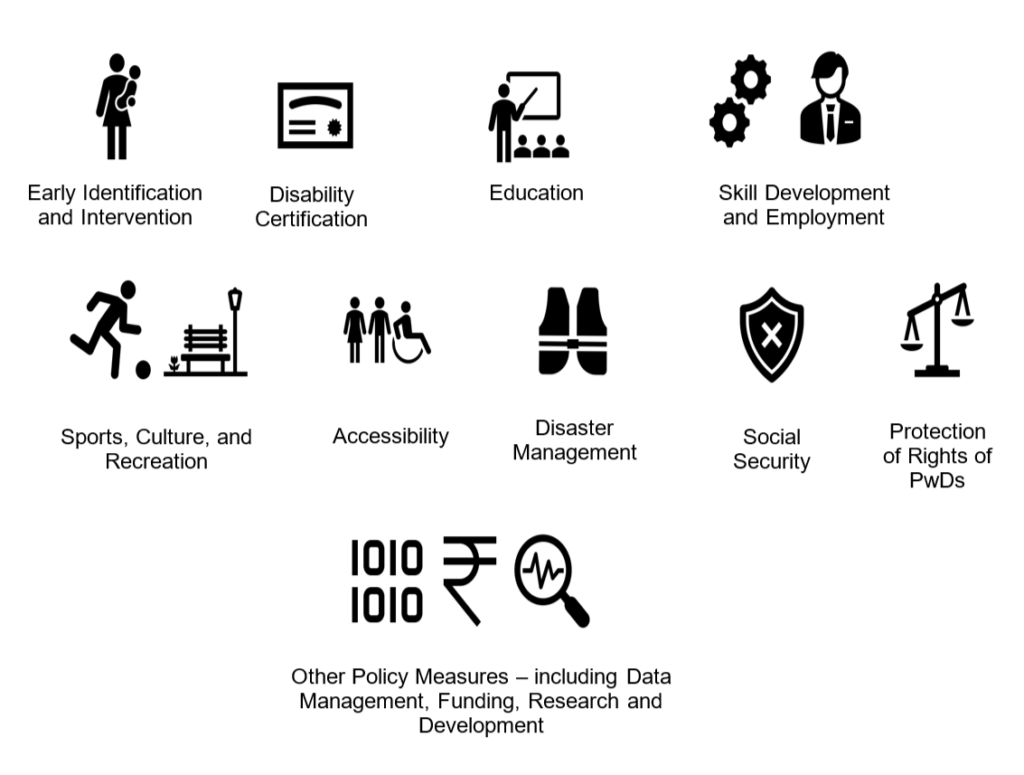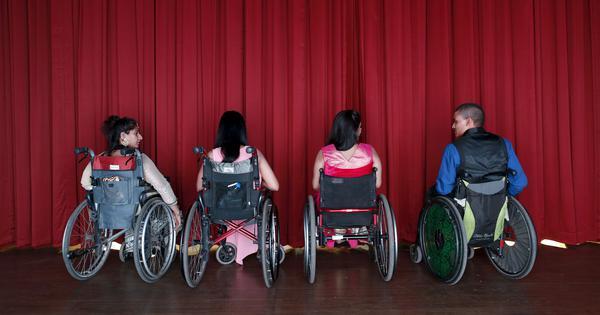India’s new Draft National Policy for Persons with Disability (NPPD), released by the Ministry of Social Justice and Empowerment in June 2022, aims to improve the lives of persons with disabilities (PwDs) from birth through life by enabling greater inclusion in eleven domains.

This policy is rooted in the principles of the United Nations Convention of Rights of People with Disability UNCRPD (2007), Incheon Strategy Asia Pacific (2013-22), India’s Rights of Persons with Disabilities (RPWD Act (2016)) and the National Education Policy NEP (2020). “Making the Right Real”, is the motto of the Incheon Strategy which sets quantified targets to reduce inequalities associated with disability in Asia and the Pacific across education, employment, public health, social security, and participation in decision making. Among various targets, the Incheon strategy commits to achieving a proportionate representation of people with disability in government decision-making by 2023. For children with disability, the NEP recognizes universalization of education and envisages the setting up of resource centers to strengthen home-based schooling, leveraging technology-based assistive solutions, providing special educator training, and ensuring barrier-free environments in schools.
Compared to the NPPD 2006, the NPPD 2022 approaches disability through a rights-based approach and places significant emphasis on disability data collection and management. But, like its 2006 counterpart, the 2022 policy is also idealistic. If the policy is not followed up with a National Strategy and plan for implementation, resourcing, well-defined targets, and impact assessment, progress towards the welfare of PwDs will not happen.
What Kind of Infrastructure Does the Policy Introduce?
The policy provides for developing a network of Cross Disability Early Intervention Centers (CDEICs) in every district, as a one-stop shop to screen children for disabilities, facilitate early diagnosis of disabilities, and initiate therapy and rehabilitation, for various types of disabilities. The CDEIC is to consist of professionals trained to assist PwD, like special educators and clinical psychologists. . This idea has its roots in recent initiatives of the Department of Empowerment of People with Disabilities, which piloted cross-disability early intervention centers in seven of its’ National Institutes and Composite Regional Centers. Having CDEICs in each district will make early intervention a reality. The DEPwD has also taken a parent-centric approach in envisioning these centers by viewing “parents as a customer”, providing parents with the emotional support and the resources to care for their children and factoring parental involvement into the design of the program.
The policy also acknowledges the overall dearth of technical, financial, and institutional state capacity toward implementing the UNCRPD principles. In a first-of-a-kind move, the policy recommends that each Central Ministry/Department should have a nodal officer on disability matters to be responsible for coordinating with the DEPwD. It also envisages an online platform for PwDs to register any complaints, enabled with the feature to automatically forward complaints to the Chief Commissioner of Persons with Disabilities or the respective State Commissioner. If implemented, this would allow for the holistic welfare of PwDs across state instrumentalities of executive and justice functions.
Persons with disabilities are also more likely to be left behind or abandoned during disasters and conflicts due to a lack of preparation and planning, as well as inaccessible facilities and services and transportation systems. In India, people with disabilities bore a disproportionate impact of the Covid-19 pandemic. PwDs remained without access to life-sustaining treatment, food, therapy, and other support systems during the lockdowns in the pandemic. In acknowledgement of this vulnerability, the policy prioritizes disability inclusive Disaster Risk Reduction approach in the plans of the National and State Disaster Management Authority. The policy stipulates that it is crucial to maintain data on PwDs, allocate resources for their welfare, and prioritize PwDs during evacuations.
What Role Does Data Play in Policies For PwDs?
In the move to create better infrastructure for PwDs, it is important to remember that one of the most necessary requirements to frame effective policy is data on the target audience. Data on disability and disabled persons in India is severely lacking. In line with Article 31 of the UNCRPD, the policy acknowledges that it is crucial to create and manage disability-specific disaggregated data across sectors of health, education, poverty alleviation, law and order, sports, and culture. The 2022 policy aims to create a national database of PwDs and link the data with program delivery and the Centre’s Unique Disability Identity (UDID). The UDID is a unique identification number allocated to PwDs (much like the Aadhaar) that would facilitate smooth access to various government entitlements and enable tracking of the allocation of resources to people with disabilities.
The emphasis on data collection and reporting and the accessibility of this data is greatly appreciated. However, a robust methodology for data collection by different government departments should be laid out in the current policy. Data from the National Sample Survey Organization (2018) estimates that the prevalence of disability in India at around 2%. But, according to the World Bank estimates, India has some 40-80 million persons with disabilities. The National Commission for the Promotion of Employment for Disabled People pegs the number of disabled at 5 – 6% or about 70 – 100 million. India does not include questions on the extent of functional difficulty in its census survey questions, which might be one reason that disability numbers are grossly underestimated. Further even the NSSO (2018) survey did not cover all 21 disabilities brought within the ambit of the Rights of People with Disabilities Act, 2016. Without specific measures to improve the credibility of disability data, it is unclear how India’s disability data is likely to become more reliable and robust.
As per the NSSO (2018) nearly 71.2% of the disabled people in India do not have disability certificates. There are inordinate delays and challenges for PwDs to obtain the central UDID. The UDID is linked to welfare entitlements such as disability pensions and railway concessions. To obtain the disability identity card, the PwDs must obtain “certification” as a disabled person. For children, even if their disability is permanent, the card is only valid for five years at a time, meaning that repeat assessments need to be carried out, even when completely unnecessary. While some states assure that a state-issued disability identity card puts PwDs on an automatic process for the UDID, several other states, require a separate assessment. A common difficulty faced in assessment is the absence of medical personnel at the assessment center. Like its 2006 predecessor, the 2022 draft policy makes a commitment to ensure that the disability identity cards shall be issued by the state authorities expeditiously and has introduced digitization in assessments too. However, considering the poor penetration of internet and cell phones in several rural areas in India, the policy does not take any additional steps to ease the application and certification process, such as leveraging networks of civil society organizations and private-public collaborations to tide over shortages in medical and paramedical personnel needed for operationalization of the scheme.
Way Forward: Bridging the Gaps in the Policy
Unlike its 2006 counterpart, the 2022 policy does not recommend that gaps between various existing policies and laws be rectified. For instance, under the Right to Education Rules, several states such as Maharashtra, Gujarat and Tamil Nadu do not include “disability” under the category of “socially disadvantaged groups”. Without this provision, many children with disability are denied admission into mainstream schools in India. Similarly in employment, the Rights of People with Disabilities Act passed in 2016 mandates that at least 3% of the jobs be filled by disabled individuals in the public sector. However many public sector organizations are nowhere near that target. In the private sector, the employment rates of PwD are far lesser. Only about 30% of employable people with disability in India are employed. The policy remains silent on how to strengthen the implementation of various pro-PwD laws in the country.
Policies will fail if they are not followed up with an implementation strategy. The 2006 policy remained dormant since it was not tied with specific objectives. Successful programs such as the Swachh Bharat Mission (India becoming open-defecation free by October 2019) and the National Tuberculosis Elimination Program (eliminate TB in India by 2025) set quantifiable targets and mobilized the collective capacity of state and non-state actors towards the achievement of these targets. The momentum set by the policy was followed up with national and local strategies for implementation and backed up with financial, technical, and human capacity- leading to the successful operationalization of the policy. As pointed out earlier, the DEPwD has recently modelled early intervention centers. But for palpable impact, this must be scaled to all districts and accountability must be fixed on specific authorities.
To overcome the stigma surrounding disability, it is necessary to go beyond the medical approach, and embrace a social and behavioural approach, to achieve inclusion in the true sense. India’s draft policy on disability is quite exhaustive and well-intended. It is reflective of India’s commitments under international conventions for inclusion and human rights provisions for people with disability. For this intent to translate into impact, we need to set targets, commit resources, and evaluate progress periodically. After all, only what gets measured, gets done.
Featured image of persons with disabilities, courtesy Stigmabase.






